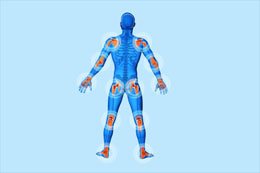Want to know more on sign and symptoms of palindromic rheumatism? Rheumatism is related to any type of arthritis or musculoskeletal disease. Let us know more about rheumatism symptoms in the following article.

The inflammation of one or more joints in the body is known as arthritis. Arthritis is also referred to as rheumatism, a general term to describe any type of pain or aches that affect the bones, muscles or joints. Rheumatism is a term used to describe disease that cannot be described by any specific arthritis or musculoskeletal disease.
Arthritis and Rheumatism Symptoms
We have seen what is arthritis and rheumatism pain. The symptoms depend on the type of arthritis or rheumatism that affects an individual. The symptoms of rheumatism are similar to that of osteoarthritis. The distinguishing feature is that, in osteoarthritis the wear and tear of the joints and ligaments leads to the pain. Whereas, in rheumatism arthritis, it the lining of the joints that gets inflamed leading to pain. The following common symptoms indicate the presence of the disease:
- Swelling in one or more joints of the body.
- There is stiffness around the joints.
- There is constant and recurring pain experienced without any possible cause.
- The joints look red and are warm when touched.
- There is sudden difficulty in moving or using a joint.
Symptoms of Palindromic Rheumatism
The palindromic rheumatism (PR) is also known as Hench-Rosenberg Syndrome or Hench's Syndrome. Palindromic rheumatism is a chronic autoimmune disease and is an abortive form of rheumatoid arthritis. It causes extreme pain and frequent disability to the patient. There are no known causes for palindromic rheumatism and can affect both men and women between 20 to 50 years of age. The signs and symptoms of palindromic rheumatism symptoms are:
- One or more joints can be affected at any one time and is usually seen in joints of the hands wrists elbows and knees.
- Palindromic rheumatism mostly affects one side of the body at a time. It is sometimes seen affecting both sides.
- The pain and inflammation, known as 'flare ups' of the affected joint last for about 4 to 5 days. Then it can stay normal for a few minutes to several weeks.
- There are some flare ups, with only pain and no inflammation and some are both.
- The flare ups can travel around the body and even jump around in the body like a pin ball.
- As the disease progresses, it may cause pain, stiffness and swelling.
- This is an autoimmune disease, thus many symptoms differ from individual to individual.
- There is permanent damage to the joints affected in rheumatoid arthritis, and joints return to normal in palindromic rheumatism, making it the main difference between the two diseases.
Muscular Rheumatism Symptoms
Muscular rheumatism is an inflammation of the fibrous or connective tissues of the body. It is also known as fibromyalgia or rheumatism. It is also called fibrositis or fibromyositis by doctors. The symptoms are as follows:
- The onset of acute rheumatism is characterized by fever and a rapid pulse rate.
- There is intense soreness and pain in the affected part.
- The tissues become sensitive and even the weight of a bed cover may increase the pain.
- The acute muscular rheumatism symptom is extreme pain with no permanent damage.
- There is swelling in the liver.
- The chronic muscular rheumatism is characterized by chronic pain and stiffness in the affected muscles.
- The pain aggravates with the movement of the muscles.
Soft Tissue Rheumatism Symptoms
The pain and inflammation of the muscles, tendons and ligaments or areas outside the joints is known as soft tissue rheumatism. The two forms of soft tissues inflammation syndrome are bursitis and tendinitis. Symptoms of soft tissue rheumatism are as follows:
- The main symptom of soft tissue rheumatism is pain.
- The bursitis soft tissue rheumatism symptoms include localized tenderness, warmth and swelling near the body surface.
- Erythema and pain, when local pressure is applied.
- There may be pain due to movement.
- The symptoms include pain with movement and especially when movement against resistance.
- There may be severe pain at night.
- The pain is mostly localized
There are certain other symptoms that can affect certain people. These symptoms include difficulty swallowing, constant headaches, diarrhea, numbness of the extremities as well as abdominal pain in some cases. Minor rheumatism may cause depression, anxiety, stress as well as sleep disturbances.
Any joint in your body can be affected with rheumatism. In case of rheumatoid arthritis, you may experience fever, loss of appetite and energy. If you suspect rheumatism, you should seek medical help promptly. If felt unattended, it may lead to severe pain as well as denudation of bones and distortion of the joints that cannot be reversed. It is always better to control the rheumatism symptoms as soon as possible then to suffer severe from pain, stiffness as well as swelling of the joints.


 The inflammation of one or more joints in the body is known as arthritis. Arthritis is also referred to as rheumatism, a general term to describe any type of pain or aches that affect the bones, muscles or joints. Rheumatism is a term used to describe disease that cannot be described by any specific arthritis or musculoskeletal disease.
The inflammation of one or more joints in the body is known as arthritis. Arthritis is also referred to as rheumatism, a general term to describe any type of pain or aches that affect the bones, muscles or joints. Rheumatism is a term used to describe disease that cannot be described by any specific arthritis or musculoskeletal disease.